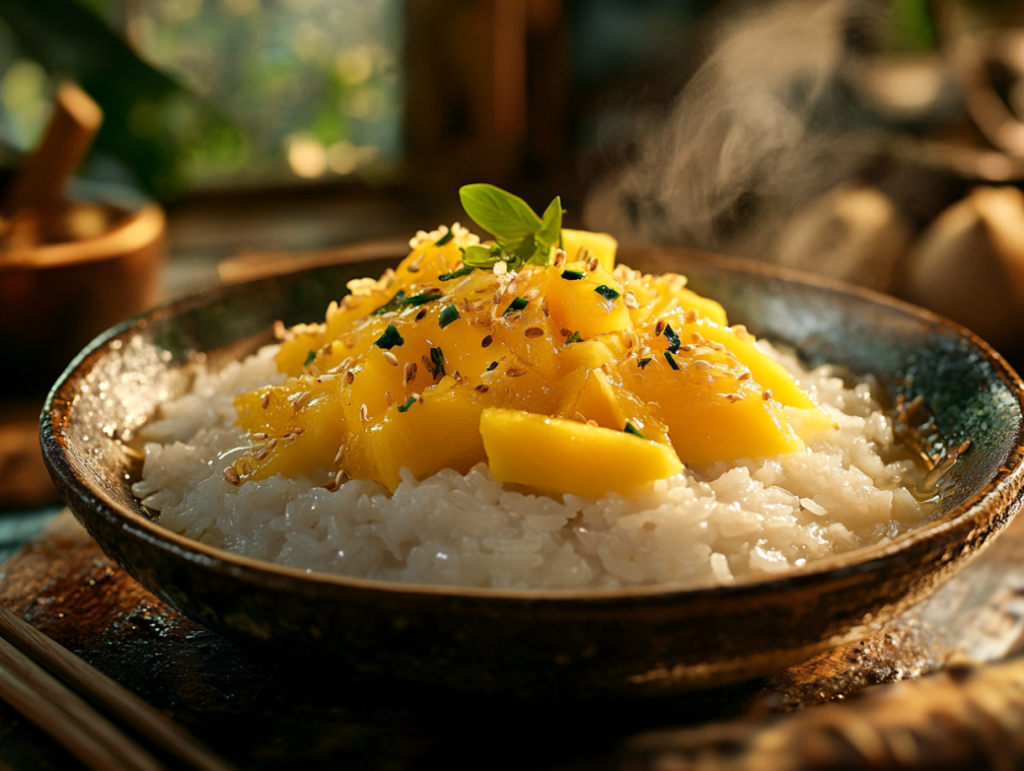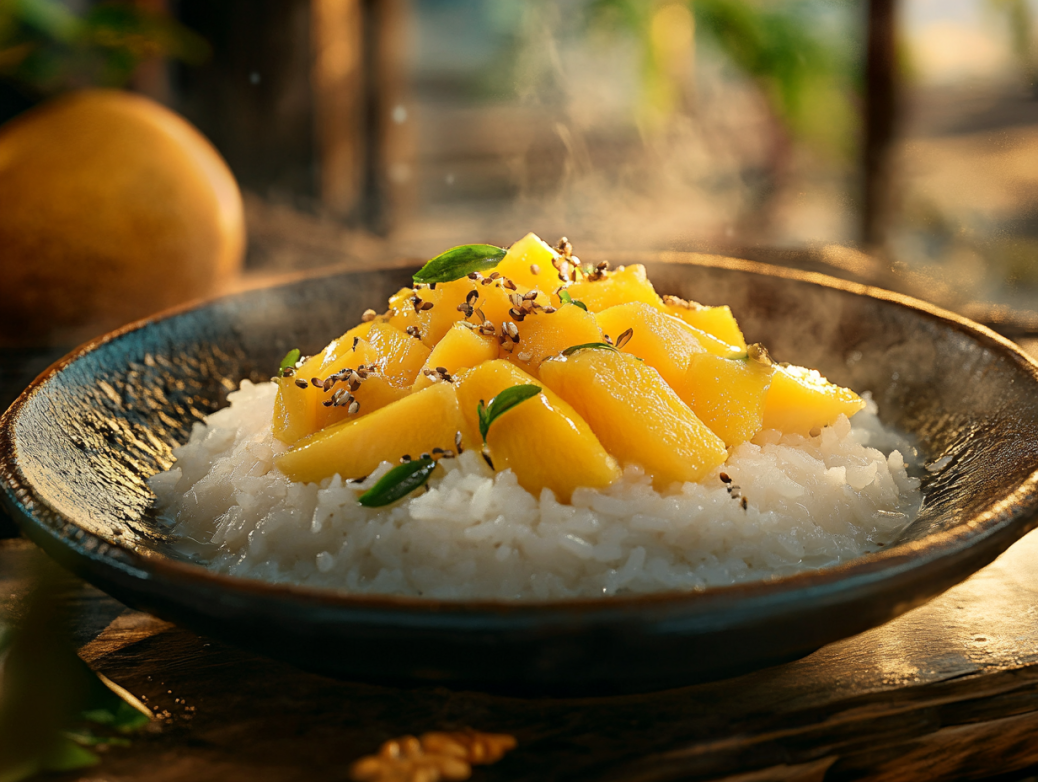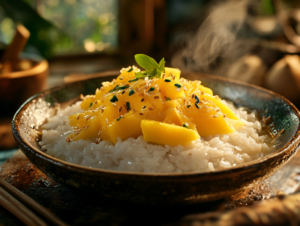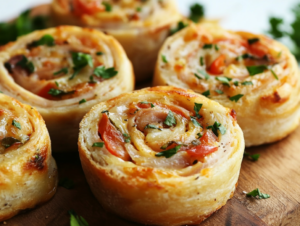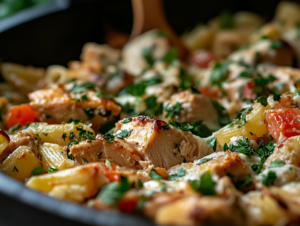Sticky Rice with Mango, or Khao Niew Mamuang, is a beloved Thai dessert that beautifully marries the creamy richness of coconut-infused sticky rice with the juicy sweetness of ripe mangoes. This iconic dish is not only a staple in Thai cuisine but has also captured the hearts of food enthusiasts worldwide.
What is Sticky Rice with Mango?
Originating from Thailand, Sticky Rice with Mango is traditionally enjoyed during the mango season, typically from April to May. The dish combines glutinous rice soaked in sweetened coconut milk, served alongside slices of fresh, ripe mango. It’s often garnished with toasted sesame seeds or mung beans, adding a delightful crunch to each bite.
Ingredients
For the Sticky Rice:
-
1 cup glutinous (sticky) rice
-
1 ¼ cups coconut milk (unsweetened)
-
4 tablespoons sugar (adjust to taste)
-
¼ teaspoon salt
For the Coconut Sauce:
-
½ cup coconut milk
-
1 ½ tablespoons sugar
-
1 ½ teaspoons cornstarch or tapioca flour
-
Pinch of salt
For Serving:
-
2 ripe mangoes, peeled and sliced
-
Toasted sesame seeds or mung beans (optional)
-
Fresh mint leaves (optional)
Preparation Details
-
Prep Time: 10 minutes
-
Cook Time: 30 minutes
-
Soaking Time: At least 4 hours or overnight
-
Total Time: Approximately 5 hours
-
Servings: 4
Directions
1. Prepare the Sticky Rice
-
Rinse the sticky rice under cold water until the water runs clear to remove excess starch.
-
Soak the rice in water for at least 4 hours or overnight.
2. Cook the Sticky Rice
-
Drain the soaked rice and place it in a steamer lined with cheesecloth or a clean kitchen towel.
-
Steam over medium heat for about 20-25 minutes until the rice becomes tender and translucent.
3. Prepare the Coconut Mixture
-
In a saucepan, combine 1 ¼ cups of coconut milk, 4 tablespoons of sugar, and ¼ teaspoon of salt.
-
Heat over medium heat until the sugar dissolves. Do not boil.
-
Once the rice is cooked, transfer it to a bowl and pour the coconut mixture over it.
-
Stir to combine, cover, and let it sit for about 30 minutes to allow the rice to absorb the coconut milk.
4. Prepare the Coconut Sauce
-
In a separate saucepan, mix ½ cup of coconut milk, 1 ½ tablespoons of sugar, 1 ½ teaspoons of cornstarch or tapioca flour, and a pinch of salt.
-
Cook over medium heat, stirring constantly, until the sauce thickens.
5. Assemble the Dish
-
Place a portion of the sticky rice on a serving plate.
-
Arrange mango slices alongside the rice.
-
Drizzle the coconut sauce over the mango and rice.
-
Garnish with toasted sesame seeds or mung beans and fresh mint leaves if desired.
Nutritional Information (Per Serving)
-
Calories: Approximately 350-400 kcal
-
Carbohydrates: 60-70g
-
Protein: 4-6g
-
Fat: 7-10g
-
Fiber: 4-5g
-
Sugar: 25-30g
Note: Nutritional values are approximate and can vary based on specific ingredients used.
Tips for the Perfect Sticky Rice with Mango
-
Rice Selection: Use authentic glutinous or sticky rice for the best texture.
-
Mango Variety: Opt for sweet, ripe mangoes like Nam Dok Mai or Ataulfo for an authentic taste.
-
Coconut Milk: Full-fat coconut milk provides a richer flavor. Shake the can well before using.
-
Serving Temperature: Serve the sticky rice warm or at room temperature, paired with chilled mango slices for contrast.
Variations to Explore
-
Black Sticky Rice: Use black glutinous rice for a nuttier flavor and striking appearance.
-
Pandan Infusion: Add pandan leaves to the coconut milk while heating for an aromatic twist.
-
Toppings: Experiment with toppings like toasted coconut flakes, crushed peanuts, or a sprinkle of cinnamon for added texture and flavor.
A Brief History
Sticky Rice with Mango has its roots in Thai culinary tradition, particularly popular during the mango harvest season. It’s a common street food in Thailand and has gained international acclaim for its delightful combination of flavors and textures. The dish exemplifies the Thai philosophy of balancing sweet, salty, and creamy elements in cuisine.
Why Soaking Sticky Rice Matters
One of the most overlooked steps in preparing sticky rice is the soaking process—but it’s absolutely critical to achieving that soft, chewy texture that defines this dessert. Glutinous rice, unlike other varieties, has a unique starch structure that benefits from long soaking. Soaking the rice for at least 4 hours, or preferably overnight, helps each grain absorb water evenly and softens the rice before steaming. This allows it to cook thoroughly without becoming mushy or unevenly textured. Skipping this step often leads to undercooked or hard rice that doesn’t absorb the coconut milk properly. The soaking also helps reduce cooking time and promotes a more fragrant, tender bite that harmonizes beautifully with the creamy, rich coconut milk. For best results, rinse the rice multiple times to remove excess surface starch, soak in cold water, and steam it in a traditional bamboo steamer if available. Mastering this step elevates the dish from average to authentic, and it’s what separates a decent Sticky Rice with Mango from a truly memorable one.
The Cultural Significance of Sticky Rice with Mango in Thailand
Sticky Rice with Mango is more than a dessert in Thailand—it’s a culinary symbol of celebration, hospitality, and seasonal abundance. Known locally as Khao Niew Mamuang, this dish is closely associated with the Thai New Year festival, Songkran, held in April, right when mangoes are at their peak ripeness. During this time, families prepare the dish to honor traditions and welcome guests with sweet offerings. The ingredients themselves are steeped in cultural meaning: sticky rice is a staple in Thai homes, representing sustenance and community, while mango is considered a luxurious fruit, symbolizing prosperity and joy. Vendors across Thailand proudly serve it at street stalls, while high-end restaurants present it with elevated flair. Internationally, Sticky Rice with Mango has become a culinary ambassador for Thai cuisine, often being the first traditional dessert that travelers experience. Its continued popularity worldwide is a testament to how food can cross borders and tell a rich cultural story through taste and texture.
Common Mistakes to Avoid When Making Sticky Rice with Mango
Even though the ingredient list is short, Sticky Rice with Mango requires attention to detail to get right. One of the most common mistakes is boiling the coconut milk mixture instead of gently heating it. High heat can cause the coconut milk to split or curdle, resulting in a grainy texture that affects the final presentation and mouthfeel. Another frequent error is using the wrong type of rice—only glutinous or “sweet” rice will achieve that signature sticky consistency. Some also forget to rest the rice after pouring in the coconut milk. This resting period is crucial; it allows the grains to fully soak in the flavors, creating the luscious, creamy texture that complements the fresh mango. Lastly, using underripe or overly ripe mangoes can ruin the balance of the dish. Ideally, mangoes should be just ripe—soft enough to cut easily but still firm and juicy, with a vibrant, sweet taste. Avoid these pitfalls, and you’ll ensure a picture-perfect and delicious dessert every time.
Where to Find Ingredients for Sticky Rice with Mango
Depending on where you live, sourcing the right ingredients might seem daunting—but it’s easier than ever thanks to international grocery stores and online marketplaces. Glutinous rice is commonly found at Asian supermarkets under names like “sweet rice” or “sticky rice.” Look for brands from Thailand or Laos for the most authentic results. Full-fat canned coconut milk is widely available and should be chosen over light versions for the richest flavor. For sugar, traditional Thai recipes use palm sugar, but granulated sugar is a convenient substitute that works well in most home kitchens. Mangoes can be a bit trickier; while you can use any ripe variety, Thai Ataulfo, Nam Dok Mai, or Manila mangoes offer the closest taste and texture to what you’d find in Thailand. These are now regularly stocked in Asian markets or seasonal sections of major grocery chains. You can even find toasted mung beans and sesame seeds in the international aisle or order them online. Having the right ingredients is key to capturing the dish’s authentic flavor and ensuring a satisfying result that transports you straight to Southeast Asia.
Conclusion
Sticky Rice with Mango is more than just a dessert; it’s a cultural experience that brings the essence of Thai cuisine to your table. Whether you’re indulging in it for the first time or recreating a favorite dish, this recipe offers a delightful journey into the heart of Thailand’s culinary heritage.
Enjoy crafting this delightful dessert and savor the harmonious blend of flavors that make Sticky Rice with Mango a timeless favorite!
Print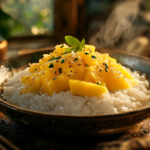
Sticky Rice with Mango : A Taste of Thai Tradition
Ingredients
For the Sticky Rice:
-
1 cup glutinous (sticky) rice
-
1 ¼ cups coconut milk (unsweetened)
-
4 tablespoons sugar (adjust to taste)
-
¼ teaspoon salt
For the Coconut Sauce:
-
½ cup coconut milk
-
1 ½ tablespoons sugar
-
1 ½ teaspoons cornstarch or tapioca flour
-
Pinch of salt
For Serving:
-
2 ripe mangoes, peeled and sliced
-
Toasted sesame seeds or mung beans (optional)
-
Fresh mint leaves (optional)
Instructions
1. Prepare the Sticky Rice
-
Rinse the sticky rice under cold water until the water runs clear to remove excess starch.
-
Soak the rice in water for at least 4 hours or overnight.
2. Cook the Sticky Rice
-
Drain the soaked rice and place it in a steamer lined with cheesecloth or a clean kitchen towel.
-
Steam over medium heat for about 20-25 minutes until the rice becomes tender and translucent.
3. Prepare the Coconut Mixture
-
In a saucepan, combine 1 ¼ cups of coconut milk, 4 tablespoons of sugar, and ¼ teaspoon of salt.
-
Heat over medium heat until the sugar dissolves. Do not boil.
-
Once the rice is cooked, transfer it to a bowl and pour the coconut mixture over it.
-
Stir to combine, cover, and let it sit for about 30 minutes to allow the rice to absorb the coconut milk.
4. Prepare the Coconut Sauce
-
In a separate saucepan, mix ½ cup of coconut milk, 1 ½ tablespoons of sugar, 1 ½ teaspoons of cornstarch or tapioca flour, and a pinch of salt.
-
Cook over medium heat, stirring constantly, until the sauce thickens.
5. Assemble the Dish
-
Place a portion of the sticky rice on a serving plate.
-
Arrange mango slices alongside the rice.
-
Drizzle the coconut sauce over the mango and rice.
-
Garnish with toasted sesame seeds or mung beans and fresh mint leaves if desired.

